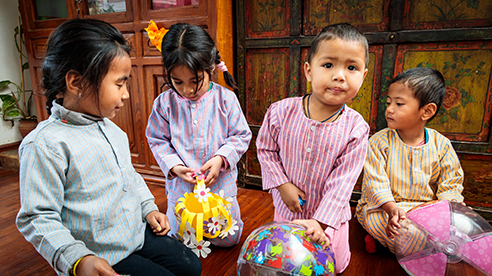Photo Credit: Chandra S. Magar
Dambar Kumari was a rebel who did not want the comfort of palaces and the life of a princess. She wanted to follow her passion and agreed to return to Nepal only on one condition, that she could practice her art in Nepal and start a cottage indust.
What can a piece of cloth tell us about a regime? A whole lot, if you know how to read the printed patterns on it. Fashion reflects the cultural and political history of the people of an era. The Ranas were extremely rich, and invested large parts of their wealth in extravagant Royal ceremonies and parties which meant that ceremonial wardrobes were a significant part of their expenditure. The expensive clothing worn by the Ranas not only portrayed the status and power of the ruling elite but also conveyed their authority. The Rana men wore military uniforms adorned with medals.

Photo credit: Gary Wornell - Kokroma
The women on the other hand, wore Victorian dresses with pearls and intricate embroidery. They had special tiaras laden with diamonds and necklaces made with pearls and other gems. During the Rana regime, the Dhaka muslin was the most treasured fabric in the world. Dhaka muslin, a cotton fabric of plain weave was imported from the city of Dhaka, in what is now Bangladesh. It was a rare form of cotton that only grew along the banks of the hallowed Meghna River. The Dhaka shawl was worn by Royals and aristocrats in Europe. It was referred to as baft hawa (woven air), aberawan (running water) by Mughal poets. Dambar Kumari, the daughter of the first Rana Prime Minister Junga Bahadur Rana, left her own mark on it, or her own print rather.
Much of Dambar Kumari’s life remains a mystery. But her story has been passed down from generation to generation through oral traditions. The story of Dambar Kumari begins not in Nepal or Bangladesh but in the 19th century Banaras, known as the Spiritual capital of India. Given the close political ties between Banaras and Nepal, one of Junga Bahadur Rana’s daughters was married to Maharaja Prabhu Narayan Singh, the ruler of Banaras, an Indian princely state. When the Maharani of Banaras sent an invitation to her sister Dambar Kumari to come on a pilgrimage to the holy city, she travelled all the way from Nepal for the trip and instantly fell in love with the holy city. There was something about Banaras that captivated Dambar Kumari and despite orders from her father to return, Dambar Kumari refused to go home. Days became weeks, weeks become months; clocks or calendars no longer made sense to her. As an additional twist to the story, rumors spreading in Kathmandu included the claim that Dambar Kumari had fallen in love with someone. Some people even invented the tale of her becoming a courtesan. Junga Bahadur could no longer stand the scandalous tales and sent his brother Dhir Shumsher to bring back his rebellious daughter. What Dhir Shumsher was unaware of was that Banaras was not only known as a Hindu pilgrimage site but was also famed for its textiles and woodblock printing since ancient times. Dhir Shumsher soon discovered the true reason behind Dambar Kumari’s reluctance to return home. The reason surprised the entire Rana family. Contrary to the rumors, Dambar Kumari had found a new passion, the ancient art of block printing on Dhaka shawls. The process was very slow and it covered every detail in the fabric but she enjoyed every bit of it. Dambar Kumari began printing trees, bushes or floral motifs on cotton which later inspired an array of captivating printed patterned textiles that still carry her name to this day.

Photo credit: Aji’s products
Dambar Kumari was a rebel who did not want the comfort of palaces and the life of a princess. She wanted to follow her passion and agreed to return to Nepal only on one condition, that she could practice her art in Nepal. She wanted to start a cottage industry producing beautiful Khasto with Dambar Kumari prints. Commissioned by royalty, her Muslin fabric, block printed with unique patterns captivated a generation of women in the Nepali palaces. The Rana women absolutely loved her designs and even Junga Bahadur’s favorite queen Putali Maharani is said to have endorsed her beautiful, block printed Khasto. Dambar Kumari employed a number of women and her dream of starting a cottage industry soon became a reality. She must have hired and trained these women as specialists and the Dambar Kumari Dhaka has since then thrived in the textile industry of Nepal. Today, Dambar Kumari printing has gone far from the traditional form of wood dipped into colorful paints used for decorating scarves and sarees. It has been re-imagined and has inspired a whole new look in fashion.











